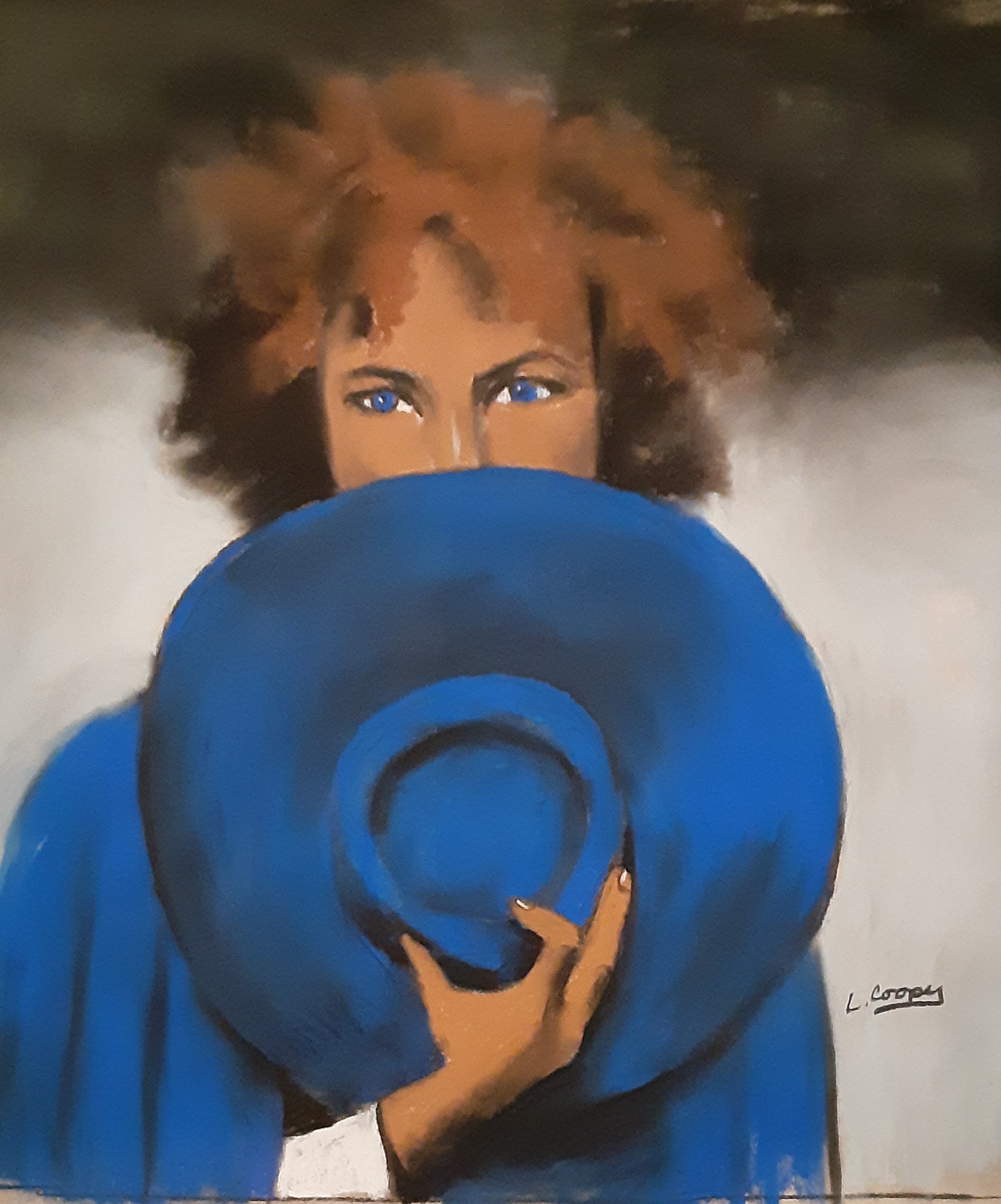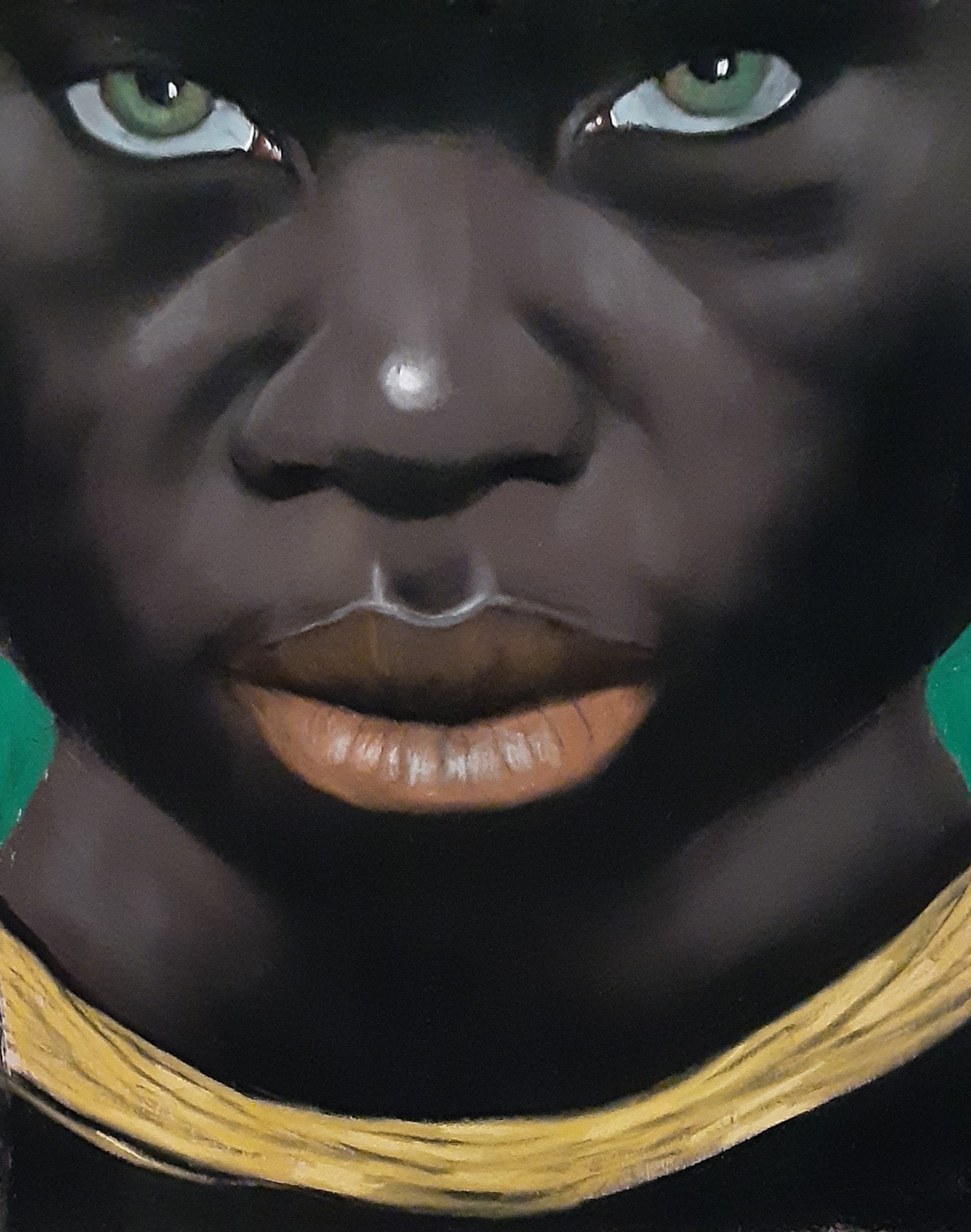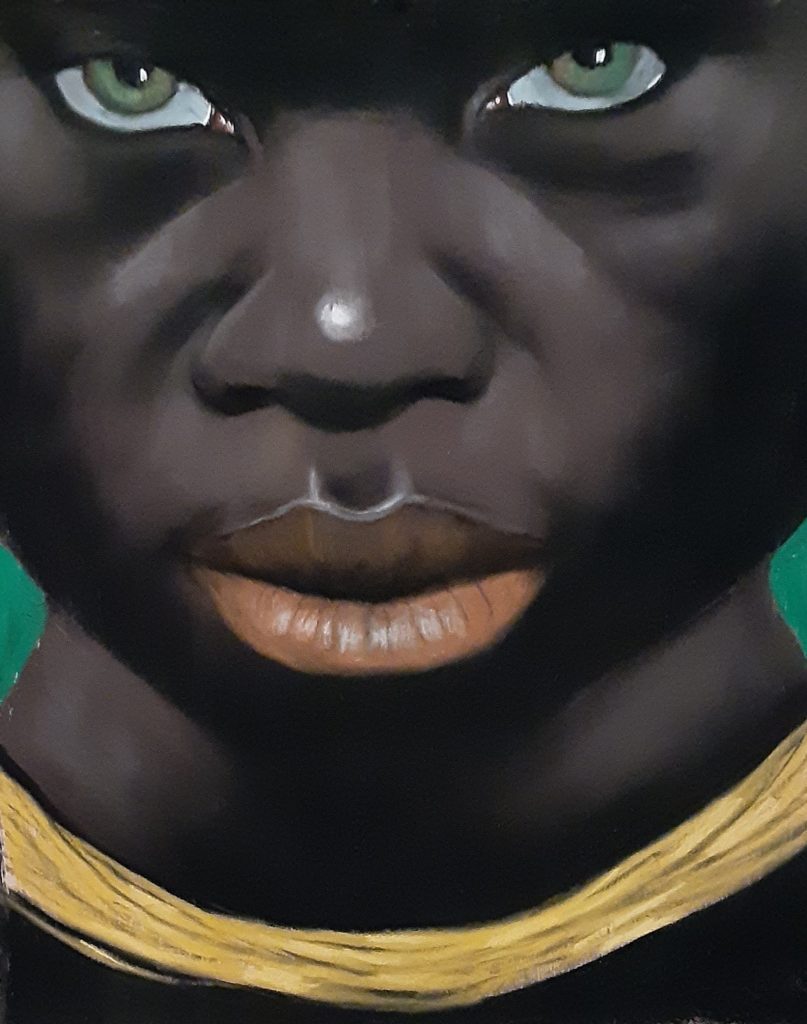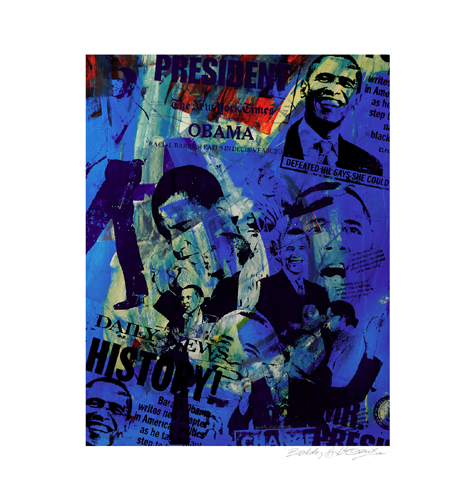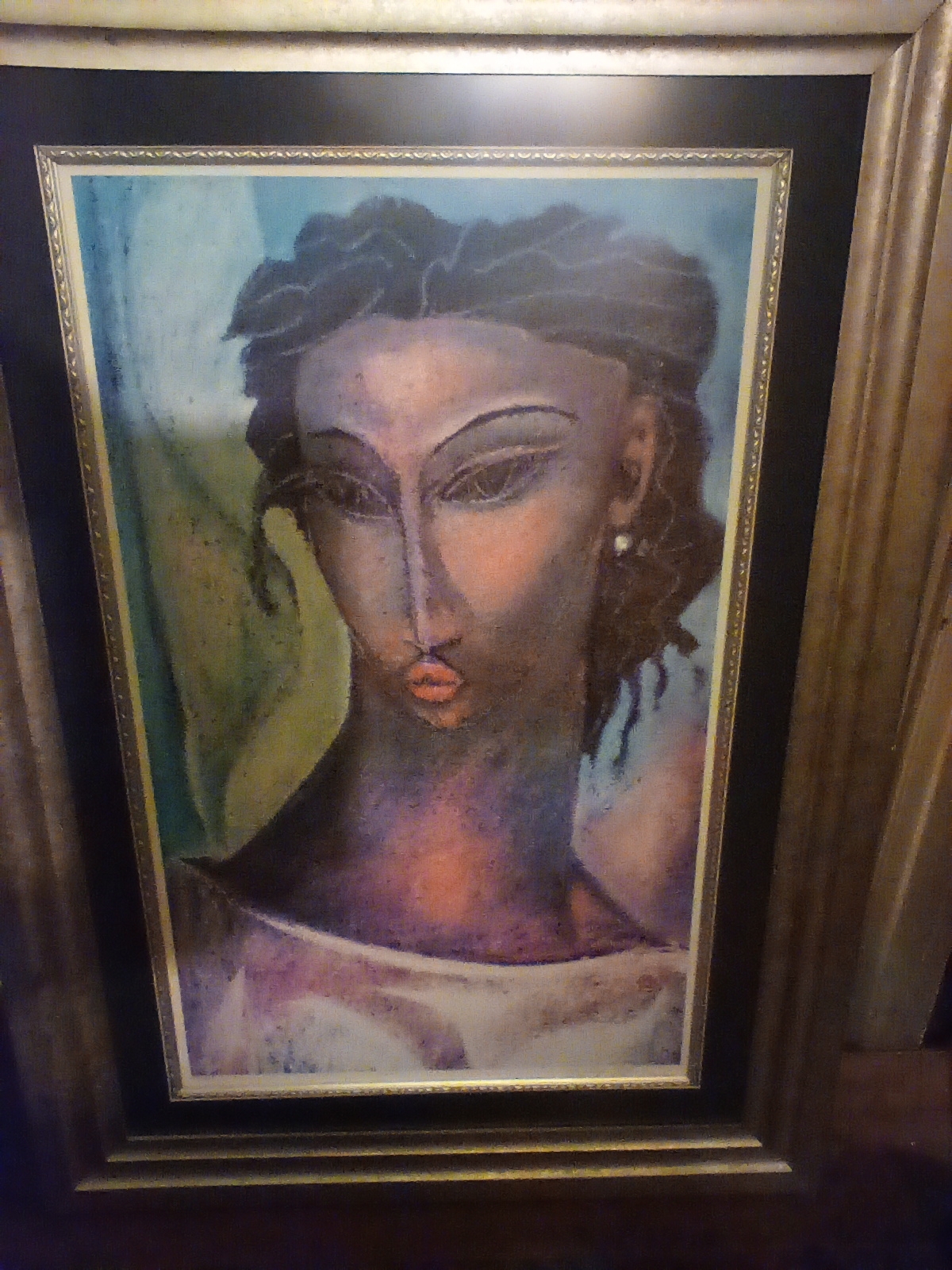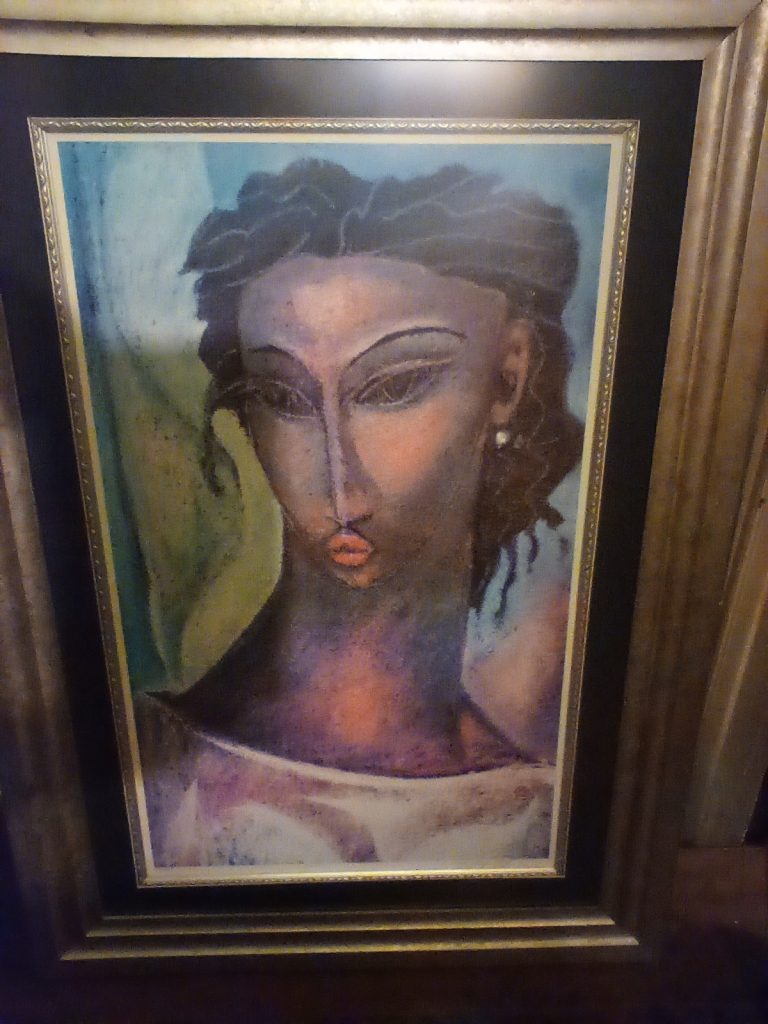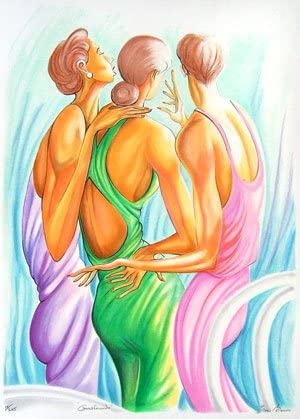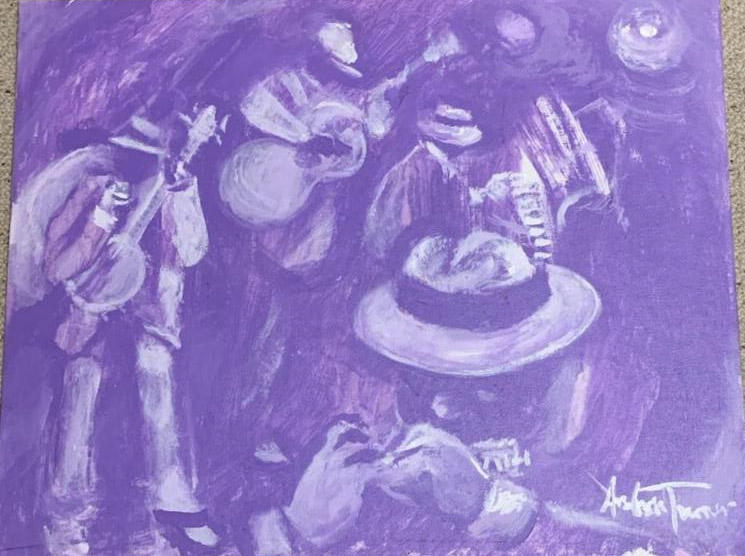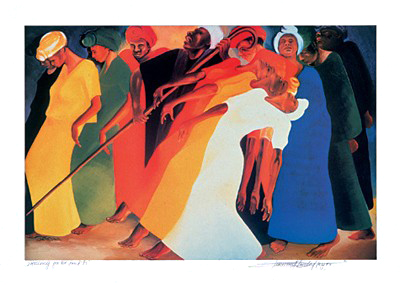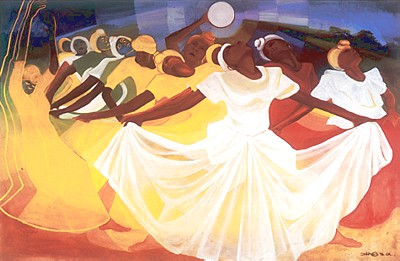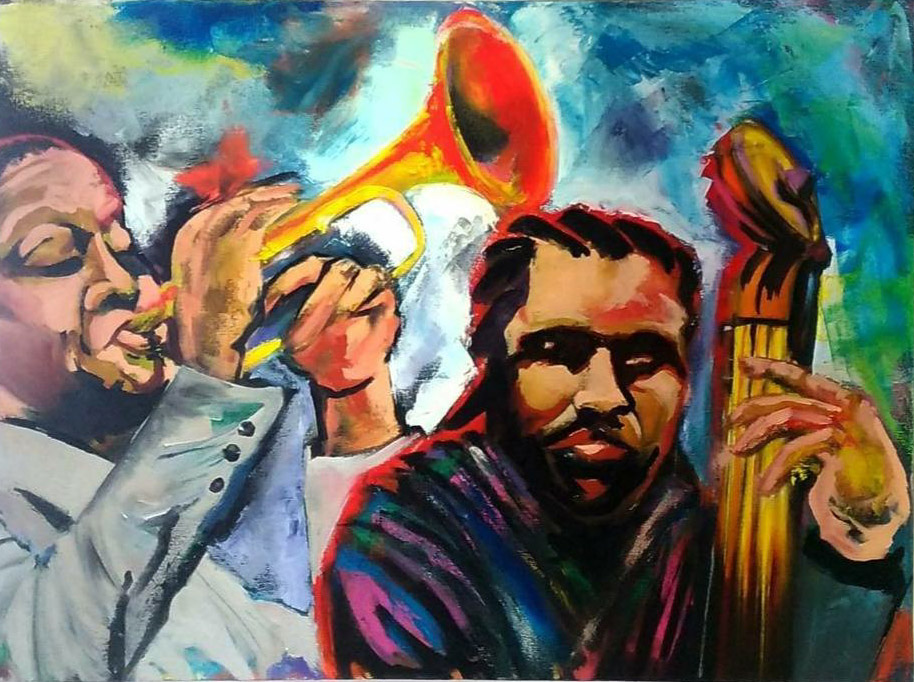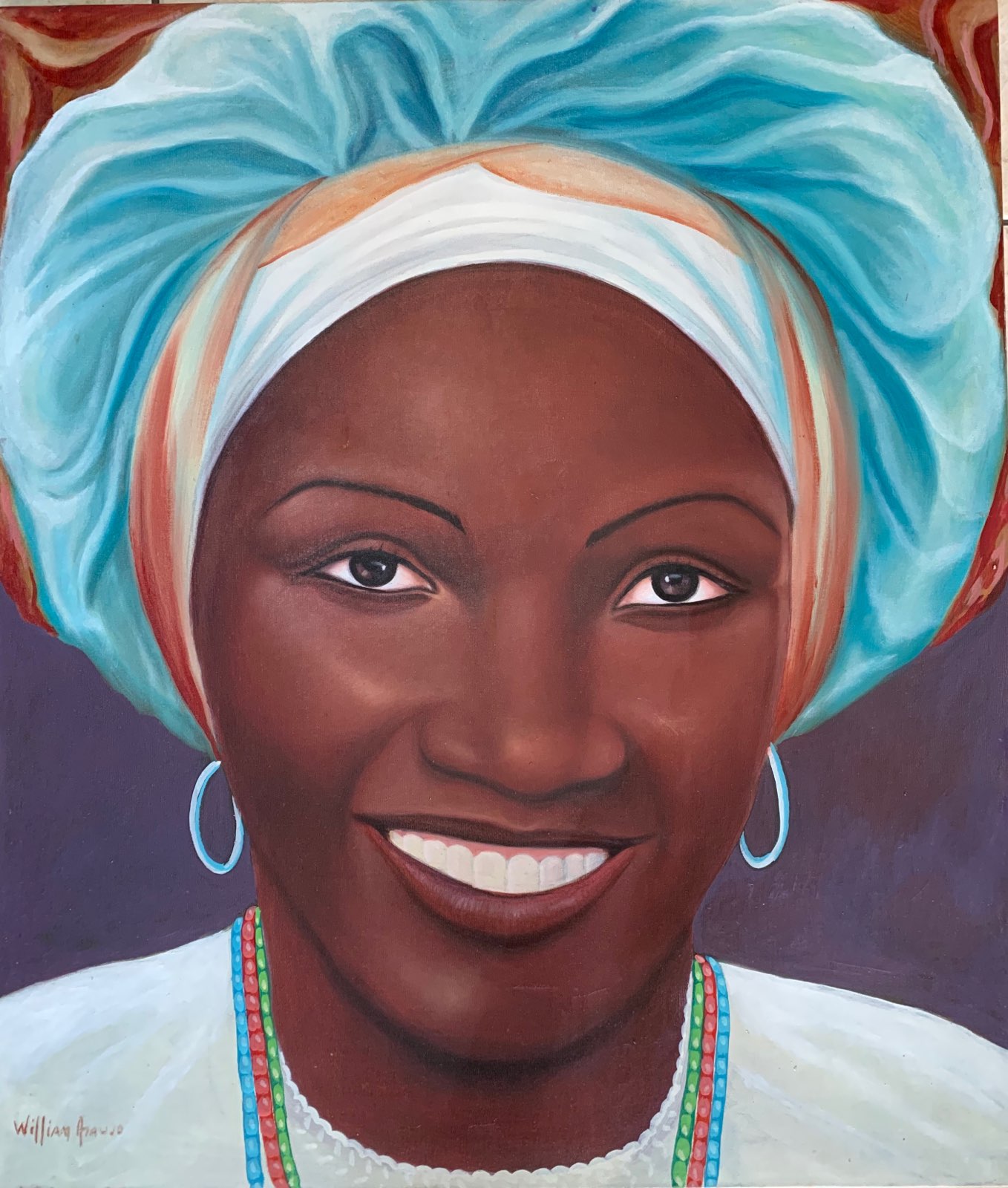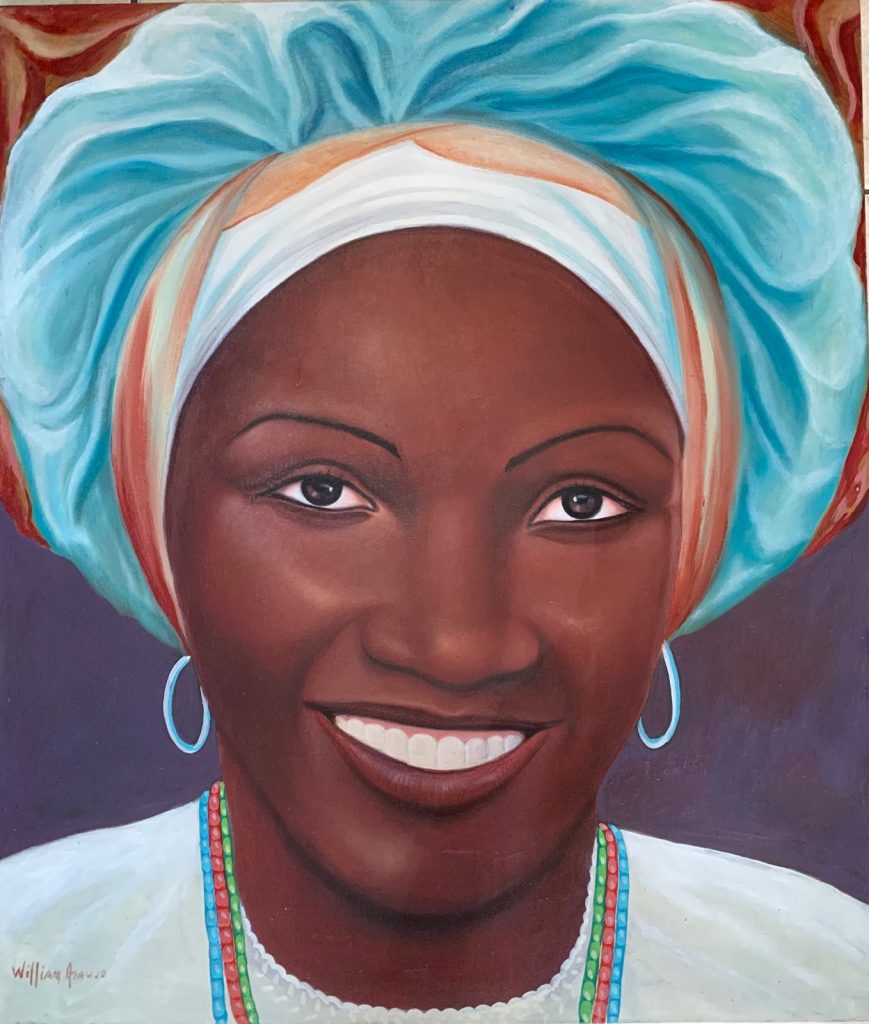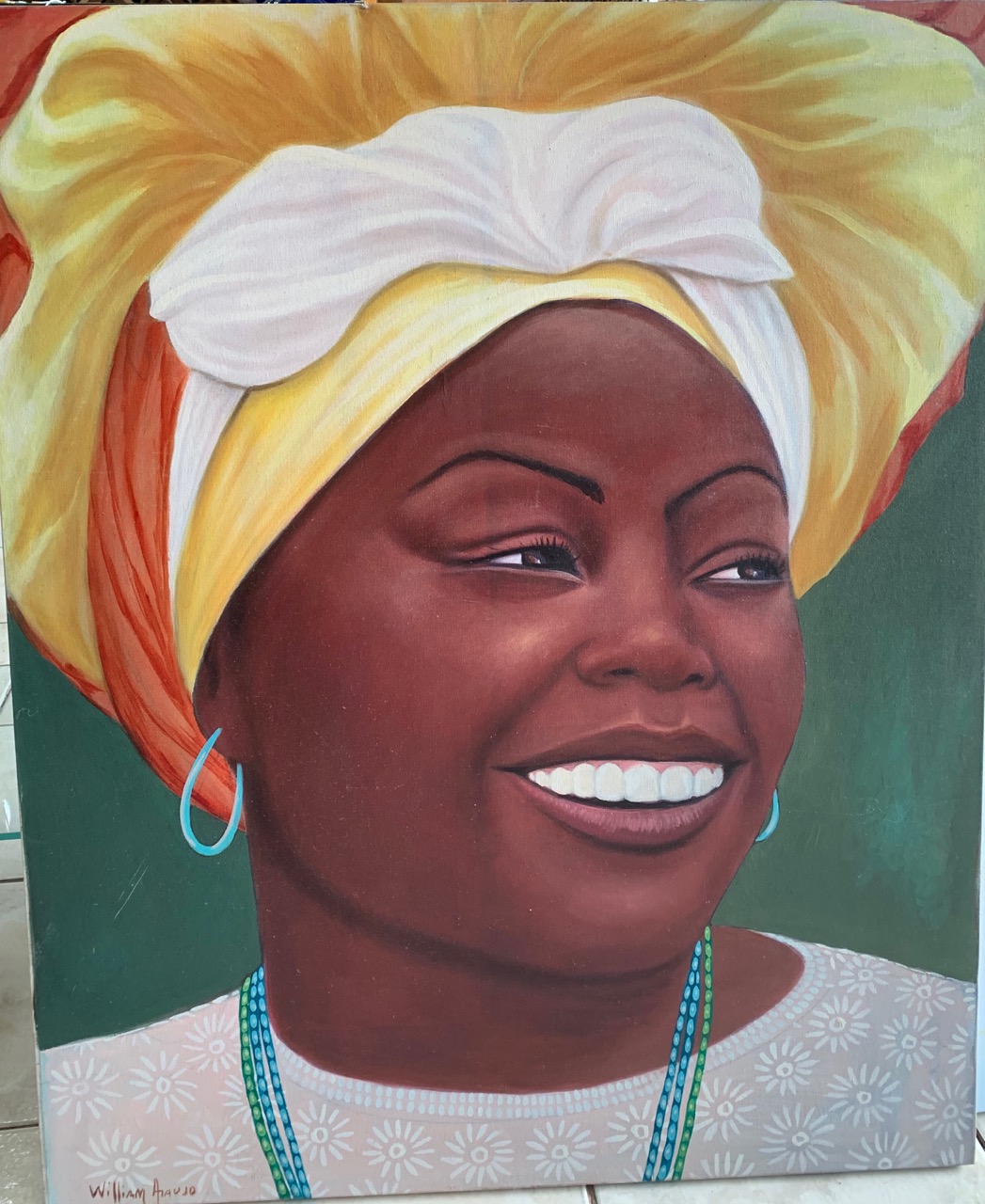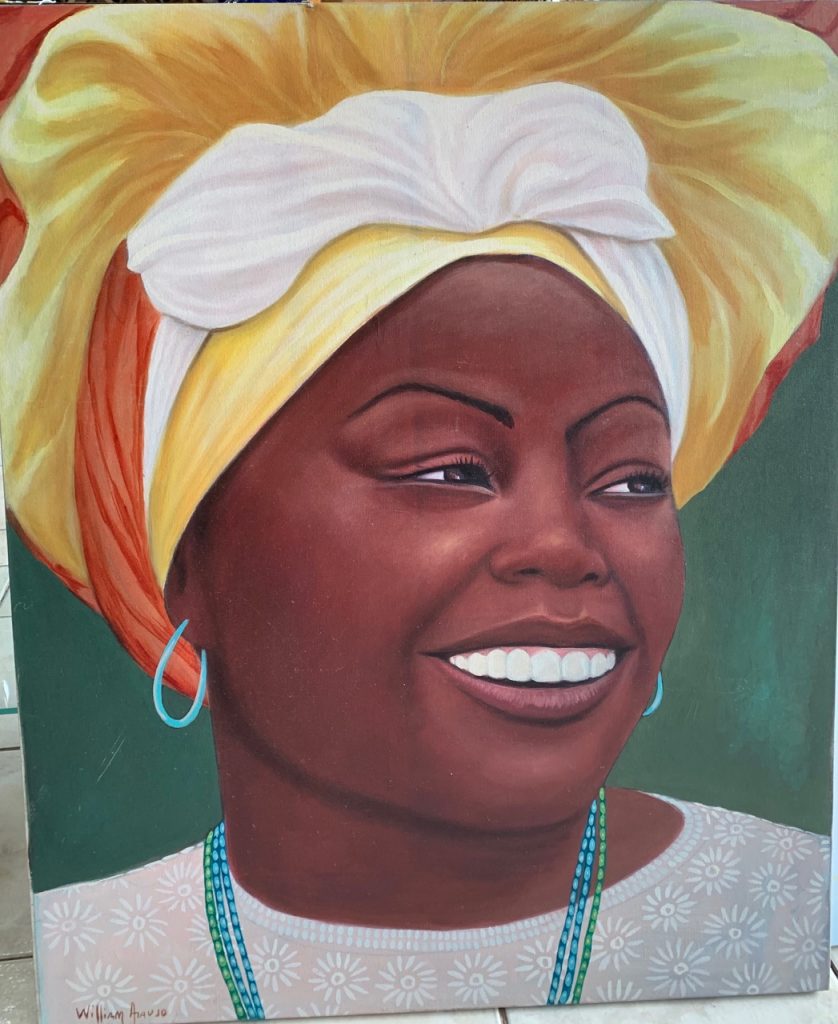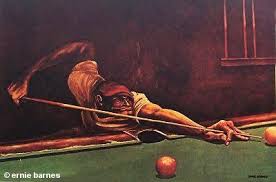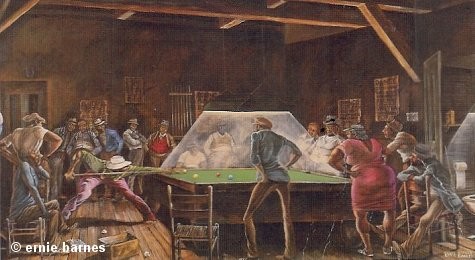SOLD
Blues
by Laurie Cooper
Original Pastel on Paper
Size: 17″ x 17″ Approx
SOLD – Look by Laurie Cooper
SOLD
Look
by Laurie Cooper
Original Pastel on Paper
Size: 17″ x 17″ Approx
Barrack Obama by Bobby Hill
Price: $175
Barrack Obama
by Bobby Hill
Pencil Signed Artist’s Proof Giclee
Size 17″ x 17 3/4″ Approx
President Barrack Obama is is portrayed as a Pop Art icon in this collage image full of history making headlines and patriotic colors. Artist: Bobby Hill Title: Obama Signature: In pencil, lower right
Bobby Hill is an artist from New York City. His art is a combination of pop imagery, graffiti and expressionism. After being in the Gen Art shows from 2002 through 2003, Bobby’s work was exhibited various places around New York, including The Grey Worldwide Gallery, MaxFish, Splash Light Studios, The Cutting Room, and The Art Directors Club.Bobby’s interest in screen-printing developed into T-shirts, and he started his own brand of tees, and hoodies. He has recently enjoyed success with huge shows in Spain, France and England, as well as SOHO.
Offered at $175

Make Offer – Ask Question
Extremely low offers will not be considered. Please do not make offers if you are not serious about buying this item.
An October Gallery ArtPro will respond to you as soon as possible.
If you prefer a telephone follow up, please leave your phone number.
Kiss by William Tolliver
OUT STOCK
Kiss
by William Tolliver
Limited Edition Lithograph
Edition of 650
Signed by the Artist
Size 22″ x 36″ Approx
Artist Bio: 1951-2000 – Tolliver spent more than 30 of his 48 years perfecting his skill as a painter. Today, William Tolliver’s art is collected worldwide. Tolliver’s style freely combines the color of Chagall with the solid compositional principles of Cezanne and the mood and forms of Modigliani and Picasso. Tolliver’s words of wisdom for the young artist were, “I would urge an art student to go to school and learn the fundamentals, because to know the fundamentals is to know the technical aspects of blending colors.”
In an age when the rules of art had either been abandoned in favor of an anti-formalist attitude or had been institutionalized in academic study, William Tolliver emerged as a brilliant self-taught artist -a Mississippi-born Renaissance man whose creative intelligence combines the study of formal structure with an innate sense of human observation. Far from the marketplace of the New York City art world, Tolliver arose during the mid-1980’s a brilliant regional talent, an individual impelled by a desire to capture the landscapes and peoples of his native deep South. Whether dealing with everyday workers or back-alley jazzmen, he conveys a universal message through sconces of the common human experience. While plaintive in mood, Tolliver’s works evoke compassion with an underlying sense of expressive emotion. “I could draw on a lot of sad and depressing things from my life, but I’d rather emphasize the positive.” An artist of insight and natural ability, Tolliver is a deliverer of an artist message imbued with unique expressions and spiritual enlistment. Tolliver was born in Vicksburg, Mississippi. Although his mother worked in the cotton fields by day, she found time to rear and help educate 14 children. To stimulate their interest in learning, she often challenged William and his older brother to drawing contests. Discovering William’s talent, she borrowed art books from the library that exposed her son to the works of the European masters. His astute observation led him to study subjects from books, black-and-white photographs, nature, comics, and family members who posed as models. Since the local public schools did not have an art curriculum, Tolliver continued his course of self-study. From inexpensive dime-store watercolor sets purchased with money earned by mowing lawns, Tolliver learned to mix and blend colors by using a paint-by-number kit. Using this system he experimented with mixing color and skin tones and by the age eight was able to create academically correct paintings.
Girlfriends by Ernie Barnes
OUT STOCK
Girlfriends
by Ernie Barnes
Limited Edition Serigraph / Edition 245
Pencil Signed and Numbered by Ernie Barnes
Size 28″ x 37″ Approx
Ernest “Ernie” Eugene Barnes, Jr. (July 15, 1938 – April 27, 2009) was an African-American painter, well known for his unique style of elongation and movement. He was also a professional football player, actor and author.
Ernie Barnes’ involvement with art began at an early age, like most gifted adult artists. However, when he reached high school his creative endeavors were temporarily detoured in his determination to become a successful athlete. In part this was a response to the demands of peer pressure which can be so strong at that age. He graduated from his high school a hero and star football player, and with 26 full athletic scholarships to choose from. He chose North Carolina Central University and a major in art. After college he continued in an illustrious professional athletic career, but never let his love for football overshadow his love for art. Football gave him an enormous satisfaction of achievement, of being able to do something extremely difficult, and do it well. Art, however, allowed him the privilege to interpret for the public his concepts of the relationship between art and life.
In 1966 Ernie Barnes retired from football to commit himself to his art. His athletic career made a special contribution to his sensibility and his art, and he often weds physical with artistic expression. Many of his subjects are satirical and he uses exaggeration, and even caricature, to enhance their mood, humor and physical vitality. Seen through Barnes’ dramatic-comic vision, human figures play out their roles in a contemporary scenario in a manner that is both entertaining and finely executed. It can easily be said that Barnes has more than established himself as one among America’s leading contemporary painters.
Barnes credits his college art instructor Ed Wilson for laying the foundation for his development as an artist. Wilson was a sculptor who instructed Barnes to paint from his own life experiences. “He made me conscious of the fact that the artist who is useful to America is one who studies his own life and records it through the medium of art, manners and customs of his own experiences.”
All his life, Barnes was ambivalent about his football experience. In interviews and in personal appearances, Barnes said he hated the violence and the physical torment of the sport. However, his years as an athlete gave him unique, in-depth observations. “(Wilson) told me to pay attention to what my body felt like in movement. Within that elongation, there’s a feeling. And attitude and expression. I hate to think had I not played sports what my work would look like.”
Barnes’ first painting sale was in 1959 for $90 to Boston Celtic Sam Jones for a painting called Slow Dance. It was subsequently lost in a fire at Jones’ home.
Critics have defined Barnes’ work as neo-mannerist. Based on his signature use of serpentine lines, elongation of the human figure, clarity of line, unusual spatial relationships, painted frames, and distinctive color palettes, art critic Frank Getlein credited Barnes as the founder of the neo-Mannerism movement – because of the similarity of technique and composition prevalent during the 16th century, as practiced by such masters as Michelangelo and Raphael.
Numerous artists have been influenced by Barnes’ art and unique style. Accordingly, several copyright infringement lawsuits have been settled and are currently pending.
Barnes created the painting Sugar Shack in the early 1970s. It gained international exposure when it was used on the Good Times television series and on a 1976 Marvin Gaye album.
Sports Art
In 1984 Barnes was appointed the Official Sports Artist for the Games of the XXIII Olympiad. Los Angeles Olympic Organizing Committee President Peter V. Ueberroth said Barnes “captured the essence of the Olympics” and “portray the city’s ethnic diversity, the power and emotion of sports competition, the singleness of purpose and hopes that go into the making of athletes the world over.” Barnes was commissioned to create five Olympic-themed paintings and serve as an official Olympic spokesman to encourage inner city youth.
In 1985 Barnes was named the first Sports Artist of the Year by the United States Sports Academy.
In 1987 Barnes created Fastbreak, a commissioned painting of the World Champion Los Angeles Lakers basketball team that included Magic Johnson, Kareem Abdul-Jabbar, James Worthy, Kurt Rambis and Michael Cooper.
In 1996 Carolina Panthers football team owners Rosalind and Jerry Richardson (Barnes’ former Colts teammate) commissioned Barnes to create the large painting Victory in Overtime (approximately 7 ft. x 14 ft.). It was unveiled before the team’s inaugural season and hangs permanently in the stadium owner’s suite.
To commemorate their 50th anniversary in 1996, the National Basketball Association commissioned Barnes to create a painting with the theme, “Where we were, where we are, and where we are going.” The painting, The Dream Unfolds hangs in the Naismith Memorial Basketball Hall of Fame in Springfield, Massachusetts. A limited edition of lithographs were made, with the first 50 prints going to each of the NBA’s 50th Anniversary All-Time Team.
In 2004 Barnes was named America’s Best Painter of Sports by the American Sport Art Museum & Archives.
Other notable sports commissions include paintings for the New Orleans Saints, Oakland Raiders and Boston Patriots football team owners.
Untitled (Three Ladies) by Andrew Turner
SOLD
Untitled (Three Ladies)
by Andrew Turner
Original Acrylic on Canvas Board
Size 20″ x 24″ Approx
Andrew Turner was born in l944 in Chester, Pennsylvania. He was a graduate of Temple University’s Tyler School of Art. Andrew’s work has been widely acclaimed, with many solo exhibitions and participation in group exhibitions. He has taught art in grades K-1 2 in the Chester, Pennsylvania Public Schools and in correctional centers. His appointments include Artist-in-Residence and Curator, Deshong Museum, Chester, PA; Lecturer, Widener University; Lecturer, Institute of Contemporary Art, University of Pennsylvania, Philadelphia, PA; and, he toured and lectured in The People’s Republic of China. Collections which hold Andrew’s paintings include Woody Allen, Dr. Maya Angelou, ARCO Chemical Company, Bell Telephone Company, Dr. Constance Clayton, Mr. and Mrs. Bill Cosby, Edie Huggins, Eric Lindros, Mr. and Mrs Louis Madonni, Moses Malone, Penn State University, the artist formerly known as Prince, Mr. and Mrs. Harold Sorgenti, Swarthmore College, Mrs. Marilyn Wheaton, and Widener University Deshong Museum, just to name a few. He has been featured in numerous solo exhibitions and group exhibitions in the United States and abroad. His Philadelphia commissions include: WDAS FM (1996); Marco Solo, (published by J. Schwinn and G. Harlow, illustrated by Andrew Turner) Reverse Angle Productions, Inc. (I 995); and Robin Hood Dell, Fairmount Park (1985).
“My paintings combine the drama inherent in seventeenth century Dutch painting with the brush work and the economy of the Impressionists. However, I look to the jazz idiom more so than to other contemporary visual artists for guidance and inspiration. I tend to measure the success of my pieces by how they stand up technically, emotionally and innovatively to a Coltrane solo or whether I’ve captured the spirit of the occasion, a la Ellington. The subject matter, sometimes nostalgic recollections of my days as a young tough, covers a myriad of common folk activities. The setting usually my native Chester, is a beehive of creative stimulation or a deteriorating ghetto depending on my state of mind. At the very least, hopefully, these vignettes of experience will help to provide insight into some African American lifestyles and serve as an inspiration to my students and others to continue the legacy of African American participation in the arts.”
Andrew Turner 1944 – 2001
Untitled (Band) by Andrew Turner
Untitled (Band)
by Andrew Turner
Original Acrylic on Canvas Board
Size 24″ x 20″ Approx
Andrew Turner was born in l944 in Chester, Pennsylvania. He was a graduate of Temple University’s Tyler School of Art. Andrew’s work has been widely acclaimed, with many solo exhibitions and participation in group exhibitions. He has taught art in grades K-1 2 in the Chester, Pennsylvania Public Schools and in correctional centers. His appointments include Artist-in-Residence and Curator, Deshong Museum, Chester, PA; Lecturer, Widener University; Lecturer, Institute of Contemporary Art, University of Pennsylvania, Philadelphia, PA; and, he toured and lectured in The People’s Republic of China. Collections which hold Andrew’s paintings include Woody Allen, Dr. Maya Angelou, ARCO Chemical Company, Bell Telephone Company, Dr. Constance Clayton, Mr. and Mrs. Bill Cosby, Edie Huggins, Eric Lindros, Mr. and Mrs Louis Madonni, Moses Malone, Penn State University, the artist formerly known as Prince, Mr. and Mrs. Harold Sorgenti, Swarthmore College, Mrs. Marilyn Wheaton, and Widener University Deshong Museum, just to name a few. He has been featured in numerous solo exhibitions and group exhibitions in the United States and abroad. His Philadelphia commissions include: WDAS FM (1996); Marco Solo, (published by J. Schwinn and G. Harlow, illustrated by Andrew Turner) Reverse Angle Productions, Inc. (I 995); and Robin Hood Dell, Fairmount Park (1985).
“My paintings combine the drama inherent in seventeenth century Dutch painting with the brush work and the economy of the Impressionists. However, I look to the jazz idiom more so than to other contemporary visual artists for guidance and inspiration. I tend to measure the success of my pieces by how they stand up technically, emotionally and innovatively to a Coltrane solo or whether I’ve captured the spirit of the occasion, a la Ellington. The subject matter, sometimes nostalgic recollections of my days as a young tough, covers a myriad of common folk activities. The setting usually my native Chester, is a beehive of creative stimulation or a deteriorating ghetto depending on my state of mind. At the very least, hopefully, these vignettes of experience will help to provide insight into some African American lifestyles and serve as an inspiration to my students and others to continue the legacy of African American participation in the arts.”
Andrew Turner 1944 – 2001
Dancing for the Lord by Bernard Hoyes
Price: $125
Dancing for the Lord
by Bernard Hoyes
Signed Open Edition
Size 31″ x 22″ Approx
Bernard Stanley Hoyes’ professional artist career began at the early age of nine in his home town of Kingston, Jamaica. Bernard’s mother sold his wood carvings and watercolors to visitors at the Jamaica Tourist Board to help maintain the household and support his creative efforts.
Hoyes first exposure to professional art education was at the institute of Jamaica, Junior Art Centre. At age 15 He moved to New York to live with his father, attend school and continue his art endeavors. He attended evening classes at the Art Students League, excelling quickly. Hoyes matured as a painter and a sculptor under the apprenticeship of established artists such as Norman Lewis, Huie Lee Smith and John Torres. A Ford Foundation Scholarship was received which allowed him to study with professional artists in a Summer Arts program at Vermont Academy in Saxtons River, Vermont.
Hoyes received a scholarship to finish his academic studies at Vermont Academy for the next two years; where his work was featured in Vermont Life, Stage IV and Vermont 70 Magazines. He was instrumental in the development of a formal Art Department there and at graduation was given a solo exhibition at the Shepardson Center Gallery on Campus. Upon graduation Hoyes received the Frederick Stanley Art Award.
Hoyes was invited by and given a Board of Trustee Grant at the College of Arts and Crafts, Oakland, California. He participated in the Graduate art show and received a Bachelor of Fine Arts Degree in painting and design. He set up a studio across the bay in San Francisco and became a full time artist. In 1975 he was participant in the ” Black Expo”, and assemblage of nationwide Afro-American artists.
At the end of 1975 he moved to Los Angeles to work as a designer for the California Museum of Science and Industry. He later resigned in 1978 returning to his studio to work as a full time artist. He became a member and active participant in many art organizations: LACE, Artist for Economic Action, Artists Equity Association, California Confederation of the Arts, Studio Z, the Graphic Arts Guild and self-help Graphics.
During the period of the late 70’s, Hoyes worked intensively on his “RAG SERIES,” encompassing over 150 pieces. He formed Caribbean Cultural Institute and Caribbean Arts, Inc. to Further expose Caribbean culture to America. The Institute provided classes, workshops and a space for cultural events centered around an Afro-centric theme. Caribbean Arts, Inc., a publication company for graphic arts was formed which led to the creation of the “CARIBBEAN COLLECTION SERIES” and the “WALLPAPER SERIES’ where old wallpaper prints were used as a source for developing new aesthetics. Hoye’s elegant “KWANZAA HOLIDAY” card series celebrates this African American holiday with functional art was created around this time.
In November 1979 Hoyes had a solo exhibition of the “RAG SERIES” at the William Grant Stills Art Center, a division of the L.A. Municipal Arts Department and a commemorative poster of “RAG NOUVEAU” was published. It has become a signature piece for the artist.
Hoyes has worked with the Los Angeles Citywide Murals Programs. Some of the murals created were: “BLACK FOLK ART IN AMERICA”, commissioned by the Craft & Folk Museum (painted with the help of the children from Wilshire Crest and Carthay Elementary Schools). Other mural were created with the assistance of children from the following schools: Sven Lokrantz School for Special Children, Mc Alister High Tri-C Program and 49th Street School for the 1984 Olympics. Hoyes continues to execute Murals in the Los Angeles Community. The most recently acclaimed, “IN THE SPIRIT OF CONTRIBUTION” commissioned by First A.M.E. Church, located on LaSalle Street in the Historic West Adams District. This mural is dedicated to both African American and Hispanic people who have made note worthy contributions to the building of America. Particularly in the area of Arts and Social/Political Advocacy.
In 1982 Hoyes returned to Jamaica and became a lecturer and assessor for the Jamaica School of Art under the direction of Cecil Cooper. He has a solo exhibition at the leading gallery, the BOLIVAR; which received critical acclaim for the exhibition featuring the “Rag Series.” The exhibition comprised of over 50 pieces included an oil painting of Jamaican hero Marcus Garvey, which now hangs in the Government House of Jamaica’s Commission. The work was selected by editor Robert A Hill and the University of California Press for the cover of Hill’s 10 volume work on Garvey, THE MARCUS GARVEY & U.N.I.A. PAPERS (1983). The original has traveled with the Garvey Centennial Exhibition sponsored by the Schomburg Center for Research in Black Culture to Museums across the country.
By this time, Hoyes had developed into a master of colorful and rhythmical compositions. On the spiritual significance of his visually engrossing powerfully expressive works, Hoyes explains that he paints “from an intuitive point of view,” that during the process the “spirits take possession” and the ritual theme becomes dominant. These insights, his Jamaican heritage and the membership of his paternal family in “revival cults” (an Afro-Christian sect with strong African retention roots) provide cues as to why these paintings are perceived as authentic revelations of altered states of reality.
The picture plane is developed from an intuitive point of view. Very little perspective is coupled with repetition and exaggeration to incorporate elements of African retention’s. Field of colors are infused with primaries in harmony. These works are intuitively inspired with no preliminary sketches. Each completed painting suggest the composition and content for the next. Color becomes personified as symbolic as various combinations are used to express national as well as spiritual connotations. The movement of the dancers is captured with posing, profiling and the preservation of facial and body expression and full figured framed against each other in dramatic crescendo. Implied lines everywhere work magic in utilizing minimum surface, textures. with much care are there to suggest/state roundness of forms, stress distances or accentuate perspective. Passionately consumed over the years with this work, a highly personal symbolism is projected that signals the arrival of a mature style. Example: “At The Table Of Zion”: this painting embraces the ritual in a spectacle of spastic bodies caught in spirit possession, around a “prepared table.” As a domestic altar, this one has a “steps feature” at the head which is unique to these cults, representing steps to heaven or steps for the gods to descend to do the bidding of mortals. From this early highlight work, a major painting with all its detailed contents is done from a bird’s eye view to give the sense of majesty and mysticism in the air.
In 1992 this prepared table comes to life in an installation for the exhibition “Massive” at the Museum of African-American Art, Los Angeles and again at Cal State Dominguez Hills Art Gallery. These tables or altars connect and mediate between the terrestrial and celestial, the material and the spiritual, the personal and communal aspect of everyday life. As the work grows from painting to installation, He was able to secure nontraditional installation spaces such as in “Casualties of Contemporary Life” installed in a burnt out building in downtown Kingston, JA. (A casualty itself from the 1977 insurrection). Also done in 1992, it calls attention to the suffering and state of the downtown and its residents, socially and physically. Ironically, Hoyes came back to Los Angeles that same week in the middle of its own insurrection. In response he immediately mount “Apparition of Healing Spirits” at several fire-bombed sites around Los Angeles to help the healing process. Allure, surrender, and love are represented by “Lures” formed from chicken meshes. These transparent figures are accompanied with ceremonial platters, fresh flowers and fruit to create a healing presence in the otherwise bleak and desolate locations of the aftermath of destruction and violence.
Hoyes mural works and other special projects demonstrate his commitment to the public good. He worked with First A.M.E. Church’s “In The Spirit Of Contribution,” which employed community youth, including African-American and Latino gang members, to get together to recognize each other’s contributions to the spiritual and peaceful unity of Los Angeles, California and the U.S. he developed a student art completion with the Jamaica Awareness Association and the California Afro-American Museum; founded the First Annual Jamaican Art Seminar & Gallery Tour sponsored by California Afro-American Museum; founded the Caribbean Cultural Institute and Caribbean Arts, Inc. a publishing and distribution company in 1982.
The City of Los Angeles Cultural Affairs Department presented an exhibition at The Watts Towers Arts Center in conjunction with the Caribbean Cultural Institute, Division of Caribbean Arts. An exhibition honoring the 25th year of his individual artistic vision, the 25th anniversary of the Watts Tower Arts Center, the 30th year of the anniversary of Kwanzaa, and the 15th year anniversary of Caribbean Arts. Titled: “Journey Through The Spirit: 25 Years of Magical Realism.” in December 1995.
For the Galerie Lakaye exhibition “Vodou Reflections.” presented in conjunction with UCLA Fowler Museum of Cultural History exhibition “Sacred Arts Of Haitian Vodou.” A ceremonial table was installed by Hoyes entitled: “Burnt Offering,” it cumulated offerings over a three month period, transforming a domestic altar-into one of personal symbolizm.
Offered at $125

Make Offer – Ask Question
Extremely low offers will not be considered. Please do not make offers if you are not serious about buying this item.
An October Gallery ArtPro will respond to you as soon as possible.
If you prefer a telephone follow up, please leave your phone number.
Surrender by Bernard Hoyes
Price: $125
Surrender
by Bernard Hoyes
Open Edition / Signed
Size 32″ x 22″ Approx
Bernard Stanley Hoyes’ professional artist career began at the early age of nine in his home town of Kingston, Jamaica. Bernard’s mother sold his wood carvings and watercolors to visitors at the Jamaica Tourist Board to help maintain the household and support his creative efforts.
Hoyes first exposure to professional art education was at the institute of Jamaica, Junior Art Centre. At age 15 He moved to New York to live with his father, attend school and continue his art endeavors. He attended evening classes at the Art Students League, excelling quickly. Hoyes matured as a painter and a sculptor under the apprenticeship of established artists such as Norman Lewis, Huie Lee Smith and John Torres. A Ford Foundation Scholarship was received which allowed him to study with professional artists in a Summer Arts program at Vermont Academy in Saxtons River, Vermont.
Hoyes received a scholarship to finish his academic studies at Vermont Academy for the next two years; where his work was featured in Vermont Life, Stage IV and Vermont 70 Magazines. He was instrumental in the development of a formal Art Department there and at graduation was given a solo exhibition at the Shepardson Center Gallery on Campus. Upon graduation Hoyes received the Frederick Stanley Art Award.
Hoyes was invited by and given a Board of Trustee Grant at the College of Arts and Crafts, Oakland, California. He participated in the Graduate art show and received a Bachelor of Fine Arts Degree in painting and design. He set up a studio across the bay in San Francisco and became a full time artist. In 1975 he was participant in the ” Black Expo”, and assemblage of nationwide Afro-American artists.
At the end of 1975 he moved to Los Angeles to work as a designer for the California Museum of Science and Industry. He later resigned in 1978 returning to his studio to work as a full time artist. He became a member and active participant in many art organizations: LACE, Artist for Economic Action, Artists Equity Association, California Confederation of the Arts, Studio Z, the Graphic Arts Guild and self-help Graphics.
During the period of the late 70’s, Hoyes worked intensively on his “RAG SERIES,” encompassing over 150 pieces. He formed Caribbean Cultural Institute and Caribbean Arts, Inc. to Further expose Caribbean culture to America. The Institute provided classes, workshops and a space for cultural events centered around an Afro-centric theme. Caribbean Arts, Inc., a publication company for graphic arts was formed which led to the creation of the “CARIBBEAN COLLECTION SERIES” and the “WALLPAPER SERIES’ where old wallpaper prints were used as a source for developing new aesthetics. Hoye’s elegant “KWANZAA HOLIDAY” card series celebrates this African American holiday with functional art was created around this time.
In November 1979 Hoyes had a solo exhibition of the “RAG SERIES” at the William Grant Stills Art Center, a division of the L.A. Municipal Arts Department and a commemorative poster of “RAG NOUVEAU” was published. It has become a signature piece for the artist.
Hoyes has worked with the Los Angeles Citywide Murals Programs. Some of the murals created were: “BLACK FOLK ART IN AMERICA”, commissioned by the Craft & Folk Museum (painted with the help of the children from Wilshire Crest and Carthay Elementary Schools). Other mural were created with the assistance of children from the following schools: Sven Lokrantz School for Special Children, Mc Alister High Tri-C Program and 49th Street School for the 1984 Olympics. Hoyes continues to execute Murals in the Los Angeles Community. The most recently acclaimed, “IN THE SPIRIT OF CONTRIBUTION” commissioned by First A.M.E. Church, located on LaSalle Street in the Historic West Adams District. This mural is dedicated to both African American and Hispanic people who have made note worthy contributions to the building of America. Particularly in the area of Arts and Social/Political Advocacy.
In 1982 Hoyes returned to Jamaica and became a lecturer and assessor for the Jamaica School of Art under the direction of Cecil Cooper. He has a solo exhibition at the leading gallery, the BOLIVAR; which received critical acclaim for the exhibition featuring the “Rag Series.” The exhibition comprised of over 50 pieces included an oil painting of Jamaican hero Marcus Garvey, which now hangs in the Government House of Jamaica’s Commission. The work was selected by editor Robert A Hill and the University of California Press for the cover of Hill’s 10 volume work on Garvey, THE MARCUS GARVEY & U.N.I.A. PAPERS (1983). The original has traveled with the Garvey Centennial Exhibition sponsored by the Schomburg Center for Research in Black Culture to Museums across the country.
By this time, Hoyes had developed into a master of colorful and rhythmical compositions. On the spiritual significance of his visually engrossing powerfully expressive works, Hoyes explains that he paints “from an intuitive point of view,” that during the process the “spirits take possession” and the ritual theme becomes dominant. These insights, his Jamaican heritage and the membership of his paternal family in “revival cults” (an Afro-Christian sect with strong African retention roots) provide cues as to why these paintings are perceived as authentic revelations of altered states of reality.
The picture plane is developed from an intuitive point of view. Very little perspective is coupled with repetition and exaggeration to incorporate elements of African retention’s. Field of colors are infused with primaries in harmony. These works are intuitively inspired with no preliminary sketches. Each completed painting suggest the composition and content for the next. Color becomes personified as symbolic as various combinations are used to express national as well as spiritual connotations. The movement of the dancers is captured with posing, profiling and the preservation of facial and body expression and full figured framed against each other in dramatic crescendo. Implied lines everywhere work magic in utilizing minimum surface, textures. with much care are there to suggest/state roundness of forms, stress distances or accentuate perspective. Passionately consumed over the years with this work, a highly personal symbolism is projected that signals the arrival of a mature style. Example: “At The Table Of Zion”: this painting embraces the ritual in a spectacle of spastic bodies caught in spirit possession, around a “prepared table.” As a domestic altar, this one has a “steps feature” at the head which is unique to these cults, representing steps to heaven or steps for the gods to descend to do the bidding of mortals. From this early highlight work, a major painting with all its detailed contents is done from a bird’s eye view to give the sense of majesty and mysticism in the air.
In 1992 this prepared table comes to life in an installation for the exhibition “Massive” at the Museum of African-American Art, Los Angeles and again at Cal State Dominguez Hills Art Gallery. These tables or altars connect and mediate between the terrestrial and celestial, the material and the spiritual, the personal and communal aspect of everyday life. As the work grows from painting to installation, He was able to secure nontraditional installation spaces such as in “Casualties of Contemporary Life” installed in a burnt out building in downtown Kingston, JA. (A casualty itself from the 1977 insurrection). Also done in 1992, it calls attention to the suffering and state of the downtown and its residents, socially and physically. Ironically, Hoyes came back to Los Angeles that same week in the middle of its own insurrection. In response he immediately mount “Apparition of Healing Spirits” at several fire-bombed sites around Los Angeles to help the healing process. Allure, surrender, and love are represented by “Lures” formed from chicken meshes. These transparent figures are accompanied with ceremonial platters, fresh flowers and fruit to create a healing presence in the otherwise bleak and desolate locations of the aftermath of destruction and violence.
Hoyes mural works and other special projects demonstrate his commitment to the public good. He worked with First A.M.E. Church’s “In The Spirit Of Contribution,” which employed community youth, including African-American and Latino gang members, to get together to recognize each other’s contributions to the spiritual and peaceful unity of Los Angeles, California and the U.S. he developed a student art completion with the Jamaica Awareness Association and the California Afro-American Museum; founded the First Annual Jamaican Art Seminar & Gallery Tour sponsored by California Afro-American Museum; founded the Caribbean Cultural Institute and Caribbean Arts, Inc. a publishing and distribution company in 1982.
The City of Los Angeles Cultural Affairs Department presented an exhibition at The Watts Towers Arts Center in conjunction with the Caribbean Cultural Institute, Division of Caribbean Arts. An exhibition honoring the 25th year of his individual artistic vision, the 25th anniversary of the Watts Tower Arts Center, the 30th year of the anniversary of Kwanzaa, and the 15th year anniversary of Caribbean Arts. Titled: “Journey Through The Spirit: 25 Years of Magical Realism.” in December 1995.
For the Galerie Lakaye exhibition “Vodou Reflections.” presented in conjunction with UCLA Fowler Museum of Cultural History exhibition “Sacred Arts Of Haitian Vodou.” A ceremonial table was installed by Hoyes entitled: “Burnt Offering,” it cumulated offerings over a three month period, transforming a domestic altar-into one of personal symbolizm.
Offered at $125

Make Offer – Ask Question
Extremely low offers will not be considered. Please do not make offers if you are not serious about buying this item.
An October Gallery ArtPro will respond to you as soon as possible.
If you prefer a telephone follow up, please leave your phone number.
African Lilies by WAK – Kevin A. Williams
OUT STOCK
African Lilies
by WAK – Kevin A. Williams
Signed and Numbered Offset Lithograph
Edition 850
Size: 26″ x 28″ Approx
Kevin A. Williams’ art is widely circulated fine art. Diverse in its themes, the art is painted by Williams in mixed mediums, and then produced in limited edition quantities. Williams also creates a number of commissioned works annually.
As the best-selling artist in the African-American print market, Williams is a popular personality at national art shows, conferences of African-American groups and major international events, including the Essence Music Festival. His art has been featured on television’s Law & Order (NBC) and Soul Food (Showtime).
Kevin A. Williams recent years have included commissioned work for celebrities, such as televisions host and movie producer Oprah Winfrey and comedian Bernie Mac, as well as corporate clients. He formed SoulVisions in May 2003.
Music by Jean Lima
SOLD
Music
by Jean Lima
Original Acrylic on Canvas
Size : 35″ x 27″ Approx
Brazilian artist from Bahia, Brazil
History of achievements in the area Graduated in Licentiate in drawing and plastic at the UFBA School of Fine Arts in 2007; Specialization in Visual Communication Design by Unifacs (in progress); Postgraduate student in the Specialization in Design at UEFS.
– Selected to exhibit at the Brazilian Art Salon in Liechtenstein – Switzerland 2019/2020 – (November to March)
– Participation and curator-ship in the collective exhibition Roots at the Contemporary Art Museum of Feira de Santana. 2019
– September to December – Participation and curator-ship in the collective exhibition Various Visual Voices at Espaço Cultural SESC Feira de Santana (Headquarters). 2019
– May to June – Participation in the collective exhibition Croma Skhema at the Contemporary Art Museum in Feira de Santana. 2018
– May and June – Participation and curator ship of the 1st International Art Exhibition (occurred simultaneously at the Contemporary Art Museum – MAC Feira; and at the Regional Art Museum – MRA CUCA). 2018
– Participation in the collective exhibition VI CAM – Art and fashion do Salvador Shopping – Salvador. 2017
– Participation in the collective exhibition Playback at Shopping Passeo Itaigara – Salvador. 2017
– Participation in the collective exhibition 2 de Julho Contemporâneo, at Centro Cultural Manoel Quirino – Salvador. 2017
– Participation in the Collective Exhibition of Illustrations Portraits of Dorian Gray in the art gallery Rosana Meireles Cultural Center of Teatro da Barra – Salvador. 2017
– Participation in the collective exhibition V CAM – Circuit of Art and Fashion – Salvador Shopping – Salvador. 2016
– Participation and award-winning work in the XIV Art of the 2nd Naval District – Salvador
SOLD – Bahiana Blue by William Araujo
SOLD
Bahiana Blue
by William Araujo
Original Acrylic on Canvas
Size 36″ x 31″ Approx
William Araujo born in Bahia, Brazil on 1959, studied Fine Arts at the Federal University of Bahia.
He has already produced paintings for the whole world for 20 years.
Have had exhibition in Barcelona, also Salvador, São Paulo and Rio de Janeiro , Brazil/.
“I’m mixed race, I’m root, I’m Paiaiá …”
“The Indian is seen by society as an animal without a soul. For they know that the soul is in the expression shown by the muscles of the face, combined with light and shadow. Captured by the eyes and reflected by the light, fed by oxygen. Result of photosynthesis produced by trees that are being felled to feed greed and destroying the vital resources for our soul.
All this combined with beauty.” William Araujo.
SOLD – Bahiana Yellow by William Araujo
SOLD
Bahiana Yellow
by William Araujo
Original Acrylic on Canvas
Size 36″ x 29″ Approx
William Araujo born in Bahia, Brazil on 1959, studied Fine Arts at the Federal University of Bahia.
He has already produced paintings for the whole world for 20 years.
Have had exhibition in Barcelona, also Salvador, São Paulo and Rio de Janeiro , Brazil/.
“I’m mixed race, I’m root, I’m Paiaiá …”
“The Indian is seen by society as an animal without a soul. For they know that the soul is in the expression shown by the muscles of the face, combined with light and shadow. Captured by the eyes and reflected by the light, fed by oxygen. Result of photosynthesis produced by trees that are being felled to feed greed and destroying the vital resources for our soul.
All this combined with beauty.” William Araujo.
Jake by Ernie Barnes / SIGNED
OUT STOCK
Jake
by Ernie Barnes
Signed by the Artist
Size 21″ x 13″ Image / 25″ x 18″ Paper Approx
Ernest “Ernie” Eugene Barnes, Jr. (July 15, 1938 – April 27, 2009) was an African-American painter, well known for his unique style of elongation and movement. He was also a professional football player, actor and author.
Ernie Barnes’ involvement with art began at an early age, like most gifted adult artists. However, when he reached high school his creative endeavors were temporarily detoured in his determination to become a successful athlete. In part this was a response to the demands of peer pressure which can be so strong at that age. He graduated from his high school a hero and star football player, and with 26 full athletic scholarships to choose from. He chose North Carolina Central University and a major in art. After college he continued in an illustrious professional athletic career, but never let his love for football overshadow his love for art. Football gave him an enormous satisfaction of achievement, of being able to do something extremely difficult, and do it well. Art, however, allowed him the privilege to interpret for the public his concepts of the relationship between art and life.
In 1966 Ernie Barnes retired from football to commit himself to his art. His athletic career made a special contribution to his sensibility and his art, and he often weds physical with artistic expression. Many of his subjects are satirical and he uses exaggeration, and even caricature, to enhance their mood, humor and physical vitality. Seen through Barnes’ dramatic-comic vision, human figures play out their roles in a contemporary scenario in a manner that is both entertaining and finely executed. It can easily be said that Barnes has more than established himself as one among America’s leading contemporary painters.
Barnes credits his college art instructor Ed Wilson for laying the foundation for his development as an artist. Wilson was a sculptor who instructed Barnes to paint from his own life experiences. “He made me conscious of the fact that the artist who is useful to America is one who studies his own life and records it through the medium of art, manners and customs of his own experiences.”
All his life, Barnes was ambivalent about his football experience. In interviews and in personal appearances, Barnes said he hated the violence and the physical torment of the sport. However, his years as an athlete gave him unique, in-depth observations. “(Wilson) told me to pay attention to what my body felt like in movement. Within that elongation, there’s a feeling. And attitude and expression. I hate to think had I not played sports what my work would look like.”
Barnes’ first painting sale was in 1959 for $90 to Boston Celtic Sam Jones for a painting called Slow Dance. It was subsequently lost in a fire at Jones’ home.
Critics have defined Barnes’ work as neo-mannerist. Based on his signature use of serpentine lines, elongation of the human figure, clarity of line, unusual spatial relationships, painted frames, and distinctive color palettes, art critic Frank Getlein credited Barnes as the founder of the neo-Mannerism movement – because of the similarity of technique and composition prevalent during the 16th century, as practiced by such masters as Michelangelo and Raphael.
Numerous artists have been influenced by Barnes’ art and unique style. Accordingly, several copyright infringement lawsuits have been settled and are currently pending.
Barnes created the painting Sugar Shack in the early 1970s. It gained international exposure when it was used on the Good Times television series and on a 1976 Marvin Gaye album.
Sports Art
In 1984 Barnes was appointed the Official Sports Artist for the Games of the XXIII Olympiad. Los Angeles Olympic Organizing Committee President Peter V. Ueberroth said Barnes “captured the essence of the Olympics” and “portray the city’s ethnic diversity, the power and emotion of sports competition, the singleness of purpose and hopes that go into the making of athletes the world over.” Barnes was commissioned to create five Olympic-themed paintings and serve as an official Olympic spokesman to encourage inner city youth.
In 1985 Barnes was named the first Sports Artist of the Year by the United States Sports Academy.
In 1987 Barnes created Fastbreak, a commissioned painting of the World Champion Los Angeles Lakers basketball team that included Magic Johnson, Kareem Abdul-Jabbar, James Worthy, Kurt Rambis and Michael Cooper.
In 1996 Carolina Panthers football team owners Rosalind and Jerry Richardson (Barnes’ former Colts teammate) commissioned Barnes to create the large painting Victory in Overtime (approximately 7 ft. x 14 ft.). It was unveiled before the team’s inaugural season and hangs permanently in the stadium owner’s suite.
To commemorate their 50th anniversary in 1996, the National Basketball Association commissioned Barnes to create a painting with the theme, “Where we were, where we are, and where we are going.” The painting, The Dream Unfolds hangs in the Naismith Memorial Basketball Hall of Fame in Springfield, Massachusetts. A limited edition of lithographs were made, with the first 50 prints going to each of the NBA’s 50th Anniversary All-Time Team.
In 2004 Barnes was named America’s Best Painter of Sports by the American Sport Art Museum & Archives.
Other notable sports commissions include paintings for the New Orleans Saints, Oakland Raiders and Boston Patriots football team owners.
Main Street Pool by Ernie Barnes
OUT STOCK
Main Street Pool
by Ernie Barnes
Limited Edition Lithography Signed and Numbered
Edition 750
Size: 16″ x 31.5″ Approx
Ernest “Ernie” Eugene Barnes, Jr. (July 15, 1938 – April 27, 2009) was an African-American painter, well known for his unique style of elongation and movement. He was also a professional football player, actor and author.
Ernie Barnes’ involvement with art began at an early age, like most gifted adult artists. However, when he reached high school his creative endeavors were temporarily detoured in his determination to become a successful athlete. In part this was a response to the demands of peer pressure which can be so strong at that age. He graduated from his high school a hero and star football player, and with 26 full athletic scholarships to choose from. He chose North Carolina Central University and a major in art. After college he continued in an illustrious professional athletic career, but never let his love for football overshadow his love for art. Football gave him an enormous satisfaction of achievement, of being able to do something extremely difficult, and do it well. Art, however, allowed him the privilege to interpret for the public his concepts of the relationship between art and life.
In 1966 Ernie Barnes retired from football to commit himself to his art. His athletic career made a special contribution to his sensibility and his art, and he often weds physical with artistic expression. Many of his subjects are satirical and he uses exaggeration, and even caricature, to enhance their mood, humor and physical vitality. Seen through Barnes’ dramatic-comic vision, human figures play out their roles in a contemporary scenario in a manner that is both entertaining and finely executed. It can easily be said that Barnes has more than established himself as one among America’s leading contemporary painters.
Barnes credits his college art instructor Ed Wilson for laying the foundation for his development as an artist. Wilson was a sculptor who instructed Barnes to paint from his own life experiences. “He made me conscious of the fact that the artist who is useful to America is one who studies his own life and records it through the medium of art, manners and customs of his own experiences.”
All his life, Barnes was ambivalent about his football experience. In interviews and in personal appearances, Barnes said he hated the violence and the physical torment of the sport. However, his years as an athlete gave him unique, in-depth observations. “(Wilson) told me to pay attention to what my body felt like in movement. Within that elongation, there’s a feeling. And attitude and expression. I hate to think had I not played sports what my work would look like.”
Barnes’ first painting sale was in 1959 for $90 to Boston Celtic Sam Jones for a painting called Slow Dance. It was subsequently lost in a fire at Jones’ home.
Critics have defined Barnes’ work as neo-mannerist. Based on his signature use of serpentine lines, elongation of the human figure, clarity of line, unusual spatial relationships, painted frames, and distinctive color palettes, art critic Frank Getlein credited Barnes as the founder of the neo-Mannerism movement – because of the similarity of technique and composition prevalent during the 16th century, as practiced by such masters as Michelangelo and Raphael.
Numerous artists have been influenced by Barnes’ art and unique style. Accordingly, several copyright infringement lawsuits have been settled and are currently pending.
Barnes created the painting Sugar Shack in the early 1970s. It gained international exposure when it was used on the Good Times television series and on a 1976 Marvin Gaye album.
Sports Art
In 1984 Barnes was appointed the Official Sports Artist for the Games of the XXIII Olympiad. Los Angeles Olympic Organizing Committee President Peter V. Ueberroth said Barnes “captured the essence of the Olympics” and “portray the city’s ethnic diversity, the power and emotion of sports competition, the singleness of purpose and hopes that go into the making of athletes the world over.” Barnes was commissioned to create five Olympic-themed paintings and serve as an official Olympic spokesman to encourage inner city youth.
In 1985 Barnes was named the first Sports Artist of the Year by the United States Sports Academy.
In 1987 Barnes created Fastbreak, a commissioned painting of the World Champion Los Angeles Lakers basketball team that included Magic Johnson, Kareem Abdul-Jabbar, James Worthy, Kurt Rambis and Michael Cooper.
In 1996 Carolina Panthers football team owners Rosalind and Jerry Richardson (Barnes’ former Colts teammate) commissioned Barnes to create the large painting Victory in Overtime (approximately 7 ft. x 14 ft.). It was unveiled before the team’s inaugural season and hangs permanently in the stadium owner’s suite.
To commemorate their 50th anniversary in 1996, the National Basketball Association commissioned Barnes to create a painting with the theme, “Where we were, where we are, and where we are going.” The painting, The Dream Unfolds hangs in the Naismith Memorial Basketball Hall of Fame in Springfield, Massachusetts. A limited edition of lithographs were made, with the first 50 prints going to each of the NBA’s 50th Anniversary All-Time Team.
In 2004 Barnes was named America’s Best Painter of Sports by the American Sport Art Museum & Archives.
Other notable sports commissions include paintings for the New Orleans Saints, Oakland Raiders and Boston Patriots football team owners.

